Urinary Self-Catheters Market Outlook
The global urinary self-catheters market size was valued at $1,722 million in 2018, and is projected to reach $2,387 million by 2026, registering a CAGR of 4.1% from 2019 to 2026.
A urinary catheter is a hollow, partially flexible tube, which is used to drain urine when an individual is unable to do it naturally. The urinary self-catheter industry is expected to experience significant growth during the forecast period, owing to rise in demand for hydrophilic intermittent catheter across geographies. Increase in number of prostate surgeries; surge in prevalence of benign prostate hyperplasia, urinary incontinence, and spinal cord injuries; rise in geriatric population, and implementation of favorable reimbursement policies for usage of intermittent catheter further boost the growth of the urinary self-catheters market. However, availability of alternatives for usage of self-catheters hampers the market growth.
Urinary Self-Catheters Market Segmentation
The global urinary self-catheters market is segmented based on product, type, application, and region. Depending on product, the market is bifurcated into intermittent catheters and external catheters. Intermittent catheters are further classified into uncoated intermittent catheters and coated intermittent catheters.
Coated intermittent catheters are subsegmented into antimicrobial, hydrophilic, and others. According to type, the market is categorized into male type catheter and female type catheter. The applications covered in the market include benign prostate hyperplasia (BPH), urinary incontinence, spinal cord injuries, and others. Region wise, the market is studied across North America (U.S., Canada, and Mexico), Europe (Germany, France, the UK, Italy, Spain, and rest of Europe), Asia-Pacific (China, Japan, Australia, India, South Korea, Taiwan, and rest of Asia-Pacific), and LAMEA (Brazil, South Africa, Saudi Arabia, Turkey, and rest of LAMEA).
Segment Review
By Product
Based on product, the intermittent catheters segment presently dominates the global market, and is anticipated to remain dominant during the forecast period. Some key factors that drive the growth of this segment are rise in demand for intermittent catheters; favorable reimbursement policies for usage of intermittent catheters; wide availability of intermittent catheters at affordable price; and increase in prevalence of benign prostate hyperplasia, urinary incontinence, spinal cord injuries, and others. Based on product, the intermittent catheters segment held more that three forth self-catheters market share in the global market in 2018.
By Application
Based on application, the spinal cord injuries segment presently leads the global market, and is anticipated to continue this trend during the forecast period. This is attributed to the fact that patients with spinal cord injuries are often unable to urinate, which is treated using intermittent catheters. Furthermore, rise in incidence of spinal cord injuries and increase in adoption of self-intermittent catheters are key drivers of this segment.
However, the benign prostate hyperplasia (BPH) segment is anticipated to exhibit fastest growth during forecast period, due to increase in prevalence of BPH and rise in number of male aging population. In addition, increase use of intermittent catheters over the indwelling catheters, owing to adverse effects associated with the use of indwelling catheters, contribute toward the market growth of this segment.
By Region
Snapshot of Asia-Pacific urinary self-catheters market
Region wise, Asia-Pacific presents lucrative opportunities for the key players operating in the urinary self-catheters market, owing to presence of high population base, increase in awareness about urinary self-catheter, development in healthcare infrastructure, and increase in demand for intermittent catheters. However, insurance companies do not cover the entire material expenses of a catheter, which is expected to hamper the market growth in Asia-Pacific.
The key players profiled in this report include Asid Bonz GmbH, B Braun Melsungen AG, Becton Dickson and Company (C.R. Bard), Boston Scientific Corporation, Coloplast A/S, ConvaTec, Hollister, Inc., Medical Technologies of Georgia, Inc., Medtronic Plc., and Teleflex Incorporated.
Key Benefits for Urinary Self-Catheters Market:
- The study provides an in-depth analysis of the urinary self-catheters market size along with the current trends and future estimations to elucidate the imminent investment pockets.
- It offers self-catheter market analysis from 2018 to 2026, which is expected to enable the stakeholders to capitalize on the prevailing opportunities in the market.
- A comprehensive urinary self-catheters market analysis of all the geographical regions is provided to determine the prevailing opportunities.
- The profiles and growth strategies of the key players are thoroughly analyzed to understand the competitive outlook and global urinary self-catheters market growth.
Urinary Self-Catheters Market Report Highlights
| Aspects | Details |
| By PRODUCT TYPE |
|
| By TYPE |
|
| By APPLICATION |
|
| By Region |
|
| Key Market Players | BOSTON SCIENTIFIC CORPORATION, TELEFLEX INCORPORATED, MEDTRONIC PLC., BECTON, DICKINSON AND COMPANY (C.R. BARD), HOLLISTER, INC., COLOPLAST A/S, MEDICAL TECHNOLOGIES OF GEORGIA, INC., B BRAUN MELSUNGEN AG, CONVATEC, ASID BONZ GmbH |
Analyst Review
A urinary catheter is a hollow, partially flexible, tube which is used to drain the urine when an individual is unable to do it naturally. The adoption of urinary self-catheters is expected to increase due to surge in the number of target population across geographies.
The urinary self-catheter market is expected to exhibit significant market growth during the forecast period, owing to increase in prevalence of benign prostate hyperplasia (BPH), urinary incontinence, and spinal cord injuries; rise in number of surgeries; and increase in geriatric population. Growth in demand for hydrophilic intermittent catheters and favorable reimbursement policies for usage of urinary catheters further support the market growth. Innovations in catheters, novel product launches, and rise in demand for intermittent catheter in emerging economies provide lucrative opportunities for the market expansion. However, the availability of substitutes of catheters and lack of awareness toward utilization of self-catheters hamper the market growth.
North America accounted for approximately one-half of the global market share in 2018, and is expected to remain dominant throughout the forecast period. This was attributed to rise in adoption of urinary self-catheter, availability of well-developed healthcare infrastructure, higher number of target population, wide availability of urinary self-catheter system, and supportive reimbursement policies for usage of these catheter. However, Asia-Pacific is expected to experience the highest growth rate during the forecast period, owing to rise in target population along with increase in adoption of urinary self-catheter systems.
Loading Table Of Content...







